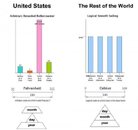BlueDevil
Contributor
For those of us that live in countries that adopted the metric system many years ago the imperial system just seems like complete craziness! Sure it takes a little while to get used to metrics at first, but once you have the hang of it you would never go back. I am not just referring to diving here, but a whole range of measures where metric is so much easier.
I guess the fact that this forum has a large US following makes it a bit frustrating for us metric fans when we encounter Fahrenheit, feet, psi, pounds etc. I started my diving career in the imperial age and did take a little while to come to terms with metric, but now it is so instinctive that I struggle to understand what people are talking about when they use imperial.
And by the way, the fact that 10m of seawater just happens to coincidentally equal 1 atmosphere of pressure is really handy.
My only gripe with the metric system as it relates to diving is tank sizes. When people went to metrics they didn't change over to an equivalent measure, but somehow decided that instead of reporting the tank size when it is full that they would report it when it is empty. This means that saying "I have a 12 litre tank" is meaningless unless you also specify the working pressure of your tank (ie it could be a 230 bar tank or a 300 bar tank, or some other pressure). I wish we had simply converted from the capacity of a full tank in cu ft to the capacity of a full tank in litres. For example a Faber 85 cuft tanks is referred to as a 10.5 litre tank, rather than [FONT=&]its full capacity of 2436 litres[/FONT] - admittedly 2426 litres doesn't roll off the tongue as easily as 10.5 litres, but no doubt it would be abbreviated to something like "24 hundred".
Anyway. what inspired this little rant is a photo I found on Facebook that shows how silly imperial is compared to metrics. I found it amusing so thought I would share it it with you. This thread is just a light hearted dig, so I hope our US forumites don't get offended.

I guess the fact that this forum has a large US following makes it a bit frustrating for us metric fans when we encounter Fahrenheit, feet, psi, pounds etc. I started my diving career in the imperial age and did take a little while to come to terms with metric, but now it is so instinctive that I struggle to understand what people are talking about when they use imperial.
And by the way, the fact that 10m of seawater just happens to coincidentally equal 1 atmosphere of pressure is really handy.
My only gripe with the metric system as it relates to diving is tank sizes. When people went to metrics they didn't change over to an equivalent measure, but somehow decided that instead of reporting the tank size when it is full that they would report it when it is empty. This means that saying "I have a 12 litre tank" is meaningless unless you also specify the working pressure of your tank (ie it could be a 230 bar tank or a 300 bar tank, or some other pressure). I wish we had simply converted from the capacity of a full tank in cu ft to the capacity of a full tank in litres. For example a Faber 85 cuft tanks is referred to as a 10.5 litre tank, rather than [FONT=&]its full capacity of 2436 litres[/FONT] - admittedly 2426 litres doesn't roll off the tongue as easily as 10.5 litres, but no doubt it would be abbreviated to something like "24 hundred".
Anyway. what inspired this little rant is a photo I found on Facebook that shows how silly imperial is compared to metrics. I found it amusing so thought I would share it it with you. This thread is just a light hearted dig, so I hope our US forumites don't get offended.





 I can understand why the decision was made to cancel the change.
I can understand why the decision was made to cancel the change.